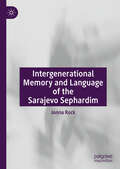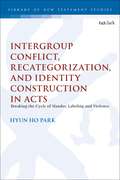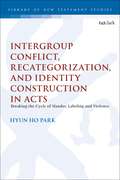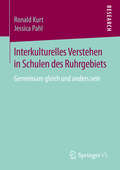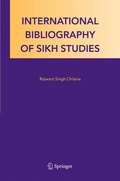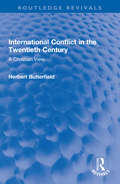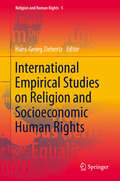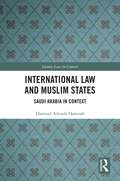- Table View
- List View
Intergenerational Memory and Language of the Sarajevo Sephardim
by Jonna RockThis book analyses issues of language and Jewish identity among the Sephardim in Sarajevo. The author examines how Sephardim belonging to three different generations in Sarajevo deal with the challenge of cultivating hybrid and hyphenated identities under destabilizing conditions, exploring how a group of interviewees define and describe the language they speak since Yugoslavia’s collapse. Their self-identification through language is then placed within the context of other cases of linguistic and ethnic identity formation in European minority groups. This book will be of interest to students and scholars working in several related fields and disciplines, including Slavic studies, Historical Anthropology, Jewish History and Holocaust studies, Sociolinguistics, and Memory studies.
Intergroup Conflict, Recategorization, and Identity Construction in Acts: Breaking the Cycle of Slander, Labeling and Violence (The Library of New Testament Studies)
by Pastor Hyun Ho ParkHyun Ho Park employs social identity to create the first thorough analysis via such methodology of Acts 21:17-23:35, which contains one of the fiercest intergroup conflicts in Acts. Park's assessment allows his readers to rethink, reevaluate, and reimagine Jewish-Christian relations; teaches them how to respond to the vicious cycle of slander, labeling, and violence permeating contemporary public and private spheres; and presents a new hermeneutical cycle and describes how readers may apply it to their own sociopolitical contexts. After surveying previous studies of the text, Park first analyses Paul's welcome, questioning, and arrest, and how slandering and labeling make Paul an outsider. Park then describes how, through defending his Jewish identity and the Way, Paul nuances his public image and re-categorizes himself and the Way as part of the people of God. When Paul identifies himself as a Roman and later a Pharisee, Park examines Luke's ambivalent attitude toward Rome and the Pharisees, and assesses how Paul escapes dangerous situations by claiming different social identities at different times. Finally, he discloses the vicious cycle of slander, labeling, and violence not only against the Way but also against the Jews and challenges the discursive process of identity construction through intergroup conflict with an out-group, especially the proximate “Other.” Furthermore, he demonstrates how the relevance of such scholarship is not limited to Lukan studies or even biblical studies in general; the frequent use of slander, labeling, and violence in the politics of the United States and other polarized countries around the globe demands new ways of looking at intergroup relations, and Park's argument meets the needs of those seeking a new perspective on contemporary political discord.
Intergroup Conflict, Recategorization, and Identity Construction in Acts: Breaking the Cycle of Slander, Labeling and Violence (The Library of New Testament Studies)
by Pastor Hyun Ho ParkHyun Ho Park employs social identity to create the first thorough analysis via such methodology of Acts 21:17-23:35, which contains one of the fiercest intergroup conflicts in Acts. Park's assessment allows his readers to rethink, reevaluate, and reimagine Jewish-Christian relations; teaches them how to respond to the vicious cycle of slander, labeling, and violence permeating contemporary public and private spheres; and presents a new hermeneutical cycle and describes how readers may apply it to their own sociopolitical contexts. After surveying previous studies of the text, Park first analyses Paul's welcome, questioning, and arrest, and how slandering and labeling make Paul an outsider. Park then describes how, through defending his Jewish identity and the Way, Paul nuances his public image and re-categorizes himself and the Way as part of the people of God. When Paul identifies himself as a Roman and later a Pharisee, Park examines Luke's ambivalent attitude toward Rome and the Pharisees, and assesses how Paul escapes dangerous situations by claiming different social identities at different times. Finally, he discloses the vicious cycle of slander, labeling, and violence not only against the Way but also against the Jews and challenges the discursive process of identity construction through intergroup conflict with an out-group, especially the proximate “Other.” Furthermore, he demonstrates how the relevance of such scholarship is not limited to Lukan studies or even biblical studies in general; the frequent use of slander, labeling, and violence in the politics of the United States and other polarized countries around the globe demands new ways of looking at intergroup relations, and Park's argument meets the needs of those seeking a new perspective on contemporary political discord.
The Interior Silence: 10 Lessons from Monastic Life
by Sarah Sands"Inspirational" - The Daily Mail"Sarah Sands has written about stillness with an eloquence that fizzes with vitality and wit. This wonderful book charts a journey to some of the most beautiful and tranquil places on earth, and introduces us to people whose inner peace is a balm for our troubled times. I loved every page of it." - Nicholas HytnerSuffering from information overload, unable to sleep, Sarah Sands, former editor of the BBC's Today programme, has tried many different strategies to de-stress... only to reject them because, as she says, all too often they threaten to become an exercise in self-absorption.Inspired by the ruins of an ancient Cistercian abbey at the bottom of her Norfolk garden, she begins to research the lives of the monks who once resided there, and realises how much we may have to learn from monasticism.Renouncing the world, monks and nuns have acquired a hidden knowledge of how to live: they labour, they learn and they acquire 'the interior silence'. This book is a quest for that hidden knowledge - a pilgrimage to ten monasteries round the world.From a Coptic desert community in Egypt to a retreat in the Japanese mountains, we follow Sands as she identifies the common characteristics of monastic life and the wisdoms to be learned from them; and as she discovers, behind the cloistered walls, a clarity of mind and an unexpected capacity for solitude which enable her, after years of insomnia, to experience that elusive, dreamless sleep.
Interiority and Law: Bahya ibn Paquda and the Concept of Inner Commandments (Stanford Studies in Jewish Mysticism)
by Omer MichaelisInteriority and Law presents a groundbreaking reassessment of a medieval Jewish classic, Baḥya ibn Paquda's Guide to the Duties of the Hearts. Michaelis reads this work anew as a revolutionary intervention in Jewish law, or halakha. Overturning perceptions of Baḥya as the shaper of an ethical-religious form of life that exceeds halakha, Michaelis offers a pioneering historical and conceptual analysis of the category of "inner commandments" developed by Baḥya. Interiority and Law reveals that Baḥya's main effort revolved around establishing a new legal formation—namely, the "duties of the hearts"—which would deal entirely with human interiority. Michaelis takes up the implications of Baḥya's radical innovation, examining his unique mystical model of proximity to God, which he based on an increasingly growing fulfillment of the inner commandments. With an integrative approach that puts Baḥya in dialogue with other medieval Muslim and Jewish religious thinkers, this work offers a fresh perspective on our understanding of the interconnectedness of the dynamic, neighboring religious traditions of Judaism and Islam. Contributing to conversations in the history of religion, Jewish studies, and medieval studies on interiority and mysticism, this book reveals Baḥya as a revolutionary and demanding thinker of Jewish law.
Interiority and Law: Bahya ibn Paquda and the Concept of Inner Commandments (Stanford Studies in Jewish Mysticism)
by Omer MichaelisInteriority and Law presents a groundbreaking reassessment of a medieval Jewish classic, Baḥya ibn Paquda's Guide to the Duties of the Hearts. Michaelis reads this work anew as a revolutionary intervention in Jewish law, or halakha. Overturning perceptions of Baḥya as the shaper of an ethical-religious form of life that exceeds halakha, Michaelis offers a pioneering historical and conceptual analysis of the category of "inner commandments" developed by Baḥya. Interiority and Law reveals that Baḥya's main effort revolved around establishing a new legal formation—namely, the "duties of the hearts"—which would deal entirely with human interiority. Michaelis takes up the implications of Baḥya's radical innovation, examining his unique mystical model of proximity to God, which he based on an increasingly growing fulfillment of the inner commandments. With an integrative approach that puts Baḥya in dialogue with other medieval Muslim and Jewish religious thinkers, this work offers a fresh perspective on our understanding of the interconnectedness of the dynamic, neighboring religious traditions of Judaism and Islam. Contributing to conversations in the history of religion, Jewish studies, and medieval studies on interiority and mysticism, this book reveals Baḥya as a revolutionary and demanding thinker of Jewish law.
Interkulturalität und Kirchengemeinde: Grundzüge einer Praxistheorie interkultureller Gemeindeentwicklung (Religion in Bewegung | Religion in Motion #3)
by Friedemann BurkhardtDie Bevölkerung in den deutschsprachigen Ländern Europas internationalisiert sich und weist eine große Pluralität auf. Diesen Entwicklungen gegenüber immun bleiben die meisten christlichen Gemeinden, was ihre gesellschaftliche Relevanz einschränkt. Friedemann Burkhardt widmet sich dem weitgehend unerforschten Komplex von Interkulturalität und Gemeinde. Er betritt mit seinen Impulsen für mehr Interkulturalität Neuland und eröffnet grundlegende theologische und gemeindepraktische Zugänge zum Interkulturalitätsbegriff. Somit plausibilisiert er den Interkulturalitätsbegriff im Sinne von Drittkulturalität als kirchentheoretische Schlüsselperspektive und legt Grundzüge einer Theorie interkultureller Gemeindeentwicklung vor.
Interkulturelle Kommunikation: Missverständnisse und Verständigung
by Edith Broszinsky-SchwabeDie Begegnung mit Menschen aus fremden Kulturen ist Normalität geworden, zunehmend auch im eigenen Land. Oft reicht unser eigenes „Rüstzeug“ für die Verständigung über kulturelle Grenzen hinweg nicht aus: Die vertraute Sprache wird nicht verstanden, Gesten werden falsch gedeutet, Zeit wird lokal verschieden wahrgenommen. Verständigung ist ohne die Kenntnis der Codes der anderen Kulturen schwierig. Entstehende Missverständnisse können soziale und wirtschaftliche Folgen haben, handfeste Konflikte oder einen Kulturschock auslösen. Deshalb bedarf es professioneller Hilfe durch Vermittlung Interkultureller Kompetenz und Interkultureller Konfliktlösungen.
Interkulturelle Kommunikation: Missverständnisse und Verständigung
by Edith Broszinsky-SchwabeDie Begegnung mit Menschen aus fremden Kulturen ist Normalität geworden, zunehmend auch im eigenen Land. Oft reicht unser eigenes „Rüstzeug“ für die Verständigung über kulturelle Grenzen hinweg nicht aus: Die vertraute Sprache wird nicht verstanden, Gesten werden falsch gedeutet, Zeit wird lokal verschieden wahrgenommen. Verständigung ist ohne die Kenntnis der Codes der anderen Kulturen schwierig. Entstehende Missverständnisse können soziale und wirtschaftliche Folgen haben, handfeste Konflikte oder einen Kulturschock auslösen. Deshalb bedarf es professioneller Hilfe durch Vermittlung Interkultureller Kompetenz und Interkultureller Konfliktlösungen.
Interkulturelles Verstehen in Schulen des Ruhrgebiets: Gemeinsam gleich und anders sein
by Ronald Kurt Jessica PahlModerne multikulturelle Gesellschaften müssen kulturelle Differenzen sozial integrieren. Das Buch sucht Antworten auf diese Fragen in der gesellschaftlichen Praxis: in Schulen des Ruhrgebiets. Hier wird Interkulturalität praktisch gelebt. Hier setzt das Forschungsprojekt – ursprünglich ein DFG-Projekt – empirisch an, indem es Schüler des Ruhrgebiets als Experten für interkulturelles Verstehen ernst nimmt. Kann die Gesellschaft von ihren Schülern interkulturelles Verstehen lernen?
International Conflict in the Twentieth Century: A Christian View (Routledge Revivals)
by Herbert ButterfieldFirst published in 1960, International Conflict in the Twentieth Century considers how to solve the problem of human relations for external affairs. Stepping back from the more common focus on "current affairs", the book explores in detail the processes and patterns of history, the principles that underlie foreign policy, the ethical issues involved in international affairs, and the role of Christianity in a time of global revolution. In doing so, it covers a variety of topics including morality, scientific approaches to politics, lessons from history, and human nature. International Conflict in the Twentieth Century will appeal to those with an interest in religion and politics, religious philosophy, and religious and political history.
International Conflict in the Twentieth Century: A Christian View (Routledge Revivals)
by Herbert ButterfieldFirst published in 1960, International Conflict in the Twentieth Century considers how to solve the problem of human relations for external affairs. Stepping back from the more common focus on "current affairs", the book explores in detail the processes and patterns of history, the principles that underlie foreign policy, the ethical issues involved in international affairs, and the role of Christianity in a time of global revolution. In doing so, it covers a variety of topics including morality, scientific approaches to politics, lessons from history, and human nature. International Conflict in the Twentieth Century will appeal to those with an interest in religion and politics, religious philosophy, and religious and political history.
International Development Policy: Religion and Development (International Development Policy)
by Gilles Carbonnier, et.al.,The rise of fundamentalist movements in major religions has forced decision-makers, development organizations and academics to turn their attention to its meaning for development. Global scholars and practitioners examine these issues and fundamentally question the secular-religious dichotomy in development discourse and practice.
International Empirical Studies on Religion and Socioeconomic Human Rights (Religion and Human Rights #5)
by Hans-Georg ZiebertzSocioeconomic rights include rights with regard to social security, labour and employment, as well as cultural rights which may be regarded as a shield for the protection of human dignity, especially of specific groups, such as women, children and refugees. The enforceability of socioeconomic rights clearly distinguishes them from other rights. These rights need, perhaps more than others, the support of civil society. Because states have leeway in how resources are distributed, civil society has a major impact on what resources are used to fulfil socio-economic rights. One of the actors in the public arena are religious traditions, respective Churches. Most of them have developed ethical standards for individual conduct and rules for living together in society based on their basic scriptures. All three monotheistic religions, Judaism, Christianity, and Islam, are marked by a caring engagement for the poor, the sick, the old and the foreign. From an empirical perspective, the general research question of this volume is how young people understand and evaluate socioeconomic rights and to which degree religious convictions and practices are connected with attitudes towards these human rights. Can religion be identified as a force supporting the human rights regime and which additional concepts strengthen or weaken the consent to these rights? The richness of empirical data contributes to a better understanding how socioeconomic rights are legitimated in the opinion of more than 10.000 respondents in 14 countries.
International Handbook of Education for Spirituality, Care and Wellbeing (International Handbooks of Religion and Education #3)
by James O'Higgins-Norman Daniel G. Scott Marian De Souza Leslie J. FrancisAcknowledging and understanding spiritual formation is vital in contemporary education. This book explores the dynamic relationship between education and wellbeing. It examines the theory underpinning the practice of education in different societies where spirituality and care are believed to be at the heart of all educational experiences. The book recognizes that, regardless of the context or type of educational experience, education is a caring activity in which the development of the whole person - body, mind and spirit - is a central aim for teachers and educators in both formal and informal learning. The chapters in this handbook present and discuss topics that focus on spirituality as an integral part of human experience and, consequently, essential to educational programs which aim to address personal and communal identity, foster resilience, empathy and compassion, and promote meaning and connectedness.
International Handbook of Inter-religious Education (International Handbooks of Religion and Education #4)
by Kath Engebretson Marian Souza Gloria Durka Liam GearonThis Handbook is based on the conviction of its editors and contributing authors that understanding and acceptance of, as well as collaboration between religions has essential educational value. The development of this Handbook rests on the f- ther assumption that interreligious education has an important role in elucidating the global demand for human rights, justice, and peace. Interreligious education reveals that the creeds and holy books of the world’s religions teach about sp- itual systems that reject violence and the individualistic pursuit of economic and political gain, and call their followers to compassion for every human being. It also seeks to lead students to an awareness that the followers of religions across the world need to be, and to grow in, dialogical relationships of respect and understa- ing. An essential aim of interreligious education is the promotion of understanding and engagement between people of different religions and, therefore, it has great potential to contribute to the common good of the global community. Interreligious education has grown from the interfaith movement, whose beg- ning is usually identi?ed with the World Parliament of Religions held in Chicago in 1893. This was the ?rst time in history that leaders of the eastern and we- ern religions had come together for dialogue, and to consider working together for global unity.
International Handbook of Jewish Education (International Handbooks of Religion and Education #5)
by Helena Miller, Lisa D. Grant and Alex PomsonThe International Handbook of Jewish Education, a two volume publication, brings together scholars and practitioners engaged in the field of Jewish Education and its cognate fields world-wide. Their submissions make a significant contribution to our knowledge of the field of Jewish Education as we start the second decade of the 21st century. The Handbook is divided broadly into four main sections:Vision and Practice: focusing on issues of philosophy, identity and planning –the big issues of Jewish Education.Teaching and Learning: focusing on areas of curriculum and engagementApplications, focusing on the ways that Jewish Education is transmitted in particular contexts, both formal and informal, for children and adults.Geographical, focusing on historical, demographic, social and other issues that are specific to a region or where an issue or range of issues can be compared and contrasted between two or more locations.This comprehensive collection of articles providing high quality content, constitutes a difinitive statement on the state of Jewish Education world wide, as well as through a wide variety of lenses and contexts. It is written in a style that is accessible to a global community of academics and professionals.
International Handbook of Learning, Teaching and Leading in Faith-Based Schools
by Judith D. Chapman Sue McNamara Michael J. Reiss Yusef WaghidThe International Handbook on Learning, Teaching and Leading in Faith Based Schools is international in scope. It is addressed to policy makers, academics, education professionals and members of the wider community. The book is divided into three sections.(1) The Educational, Historical, Social and Cultural Context, which aims to: Identify the educational, historical, social and cultural bases and contexts for the development of learning, teaching and leadership in faith-based schools across a range of international settings;Consider the current trends, issues and controversies facing the provision and nature of education in faith-based schools; Examine the challenges faced by faith-based schools and their role and responses to current debates concerning science and religion in society and its institutions.(2) The Nature, Aims and Values of Education in Faith-based Schools, which aims to: Identify and explore the distinctive philosophies, characteristics and guiding principles, values, concepts and concerns underpinning learning, teaching and leadership in faith-based schools;Identify and explore ways in which such distinctive philosophies of education challenge and expand different norms and conventions in their surrounding societies and cultures;Examine and explore some of the ways in which different conceptions within and among different religious and faith traditions guide practices in learning, teaching and leadership in various ways.(3) Current Practice and Future Possibilities, which aims to:Provide evidence of current educational practices that might help to inform and shape innovative and successful policies, initiatives and strategies for the development of quality learning, teaching and leadership in faith-based schools;Examine the ways in which the professional learning of teachers and educational leaders in faith- based settings might be articulated and developed;Consider the ways in which coherence and alignment might be achieved between key national priorities in education and the identity, beliefs, and the commitments of faith-based schools; Examine what international experience shows about the place of faith-based schools in culturally rich and diverse communities and the implications of faith-based schooling for societies of the future.
International Handbook of Protestant Education (International Handbooks of Religion and Education #6)
by William Jeynes and David W. RobinsonSince their earliest days, institutions providing a Protestant education have always been respected and sought-after for their rigor and relative freedom from dogma—and despite today’s secularism and plurality, they remain so. This international handbook is the ultimate companion to protestant schooling worldwide. Its 39 chapters form the most comprehensive and wide-ranging treatment of the subject yet available, addressing Protestant education on all six inhabited continents and featuring the perspectives of leading authorities and public figures.The contributions cover in detail not only the facts and features of Protestant schooling in sundry nations, but also integrate a range of themes common to them all, themes so vital that they are of central concern to Christians around the world and of whatever denomination. Some of these topics are school choice, globalization, Bible pedagogy and character education, the fine arts, parental involvement, and the rise of Christianity in previously inaccessible locations such as China.The handbook’s stellar list of authors is a Who’s Who of authorities on the subject and includes a renowned American evangelical, a former historian of the US House of Representatives, and White House consultants responsible for framing legislation. The many contributors from outside the USA are leading academics conducting seminal research on numerous topics in the field. Both exhaustive and authoritative, The International Handbook of Protestant Educationwill be an invaluable asset to educators, ministers, parents, policy makers political leaders of any denomination—or none.
The International Impact of the Boer War
by Keith M. WilsonAlthough much has been written about the conduct of the war in South Africa, very little has been written about how it was regarded on the world stage by powers both great and small. This collection of specially commissioned essays seeks for the first time to put the Boer War (1899-1902) in its international context. Each of the core chapters focuses on the perspective of one country (France, Germany, Austria-Hungary, Italy, The Netherlands, Portugal, Russia, and the United States) and assesses the extent to which each national government tried to capitalize on Britain's embarrassment and distraction while often entangled in imperialist ventures of their own. The anglophobia of many of the nations' press, the activities of pro-Boer organizations, and the shaping of public and parliamentary opinion are examined alongside the real politics and diplomatic considerations that took precedence. In addition, there are summation chapters that examine both the origins of the war and its legacy for Britain's expansionist ambitions. Together these essays present the latest findings on a watershed in international relations that heralded substantive changes of attitude and policy on the part of national governments towards their dependencies and had far-reaching consequences for alliance systems and the international balance of power at the start of the twentieth century.
The International Impact of the Boer War
by Keith M. WilsonAlthough much has been written about the conduct of the war in South Africa, very little has been written about how it was regarded on the world stage by powers both great and small. This collection of specially commissioned essays seeks for the first time to put the Boer War (1899-1902) in its international context. Each of the core chapters focuses on the perspective of one country (France, Germany, Austria-Hungary, Italy, The Netherlands, Portugal, Russia, and the United States) and assesses the extent to which each national government tried to capitalize on Britain's embarrassment and distraction while often entangled in imperialist ventures of their own. The anglophobia of many of the nations' press, the activities of pro-Boer organizations, and the shaping of public and parliamentary opinion are examined alongside the real politics and diplomatic considerations that took precedence. In addition, there are summation chapters that examine both the origins of the war and its legacy for Britain's expansionist ambitions. Together these essays present the latest findings on a watershed in international relations that heralded substantive changes of attitude and policy on the part of national governments towards their dependencies and had far-reaching consequences for alliance systems and the international balance of power at the start of the twentieth century.
International Law and Muslim States: Saudi Arabia in Context (Islamic Law in Context)
by Dawood Adesola HamzahThis book analyses the general interaction between international law and Islamic law in the Muslim world today. It interrogates factors that often form the root of the tension between the two legal regimes. Literalist interpretations of Islamic law and the modern international law's disposition that does not give due consideration to differences among cultures and civilizations are some of these factors. This work examines the Saudi Arabia textualist approach to the two primary sources of law in Islam, the Qur’an and Sunnah, and argues that a liberal approach of interpretation has become sine qua non especially now that myriad issues are confronting the Muslim world generally and Saudi Arabia in particular. Similarly, globalization has generated an unprecedented multi-culturalism, legal-pluralism, and trans-border interactions in socio-economic and political relations. Therefore, Saudi Arabia, as the bastion of Islam and Islamic nations, is faced with the imperative of adopting a liberal approach to interpretation of Islamic law, with a view to accommodating a wide spectrum of other laws and cultures. The book provides a timely examination of the issue of modern Saudi Arabia, Islamic legal order vis-à-vis the contemporary concept of international law and international relations in specific areas such as international human rights law and trans-national economic matters. As such it will be of interest to academics and researchers working in Islamic law, international and comparative law, human rights law, and law and religion.
International Law and Muslim States: Saudi Arabia in Context (Islamic Law in Context)
by Dawood Adesola HamzahThis book analyses the general interaction between international law and Islamic law in the Muslim world today. It interrogates factors that often form the root of the tension between the two legal regimes. Literalist interpretations of Islamic law and the modern international law's disposition that does not give due consideration to differences among cultures and civilizations are some of these factors. This work examines the Saudi Arabia textualist approach to the two primary sources of law in Islam, the Qur’an and Sunnah, and argues that a liberal approach of interpretation has become sine qua non especially now that myriad issues are confronting the Muslim world generally and Saudi Arabia in particular. Similarly, globalization has generated an unprecedented multi-culturalism, legal-pluralism, and trans-border interactions in socio-economic and political relations. Therefore, Saudi Arabia, as the bastion of Islam and Islamic nations, is faced with the imperative of adopting a liberal approach to interpretation of Islamic law, with a view to accommodating a wide spectrum of other laws and cultures. The book provides a timely examination of the issue of modern Saudi Arabia, Islamic legal order vis-à-vis the contemporary concept of international law and international relations in specific areas such as international human rights law and trans-national economic matters. As such it will be of interest to academics and researchers working in Islamic law, international and comparative law, human rights law, and law and religion.
International Perspectives on Education, Religion and Law (Routledge Research in Religion and Education)
by Charles J. RussoThis volume examines the legal status of religion in education, both public and non-public, in the United States and seven other nations. It will stimulate further interest, research, and debate on comparative analyses on the role of religion in schools at a time when the place of religion is of vital interest in most parts of the world. This interdisciplinary volume includes chapters by leading academicians and is designed to serve as a resource for researchers and educational practitioners, providing readers with an enhanced awareness of strategies for addressing the role of religion in rapidly diversifying educational settings. There is currently a paucity of books devoted solely to the topic written for interdisciplinary and international audiences involving educators and lawyers, and this book will clarify the legal complexities and technical language among the law, education, and religion.
